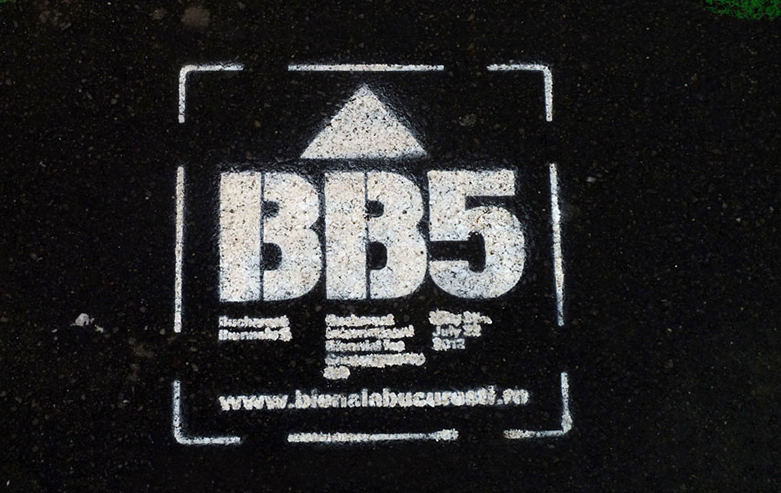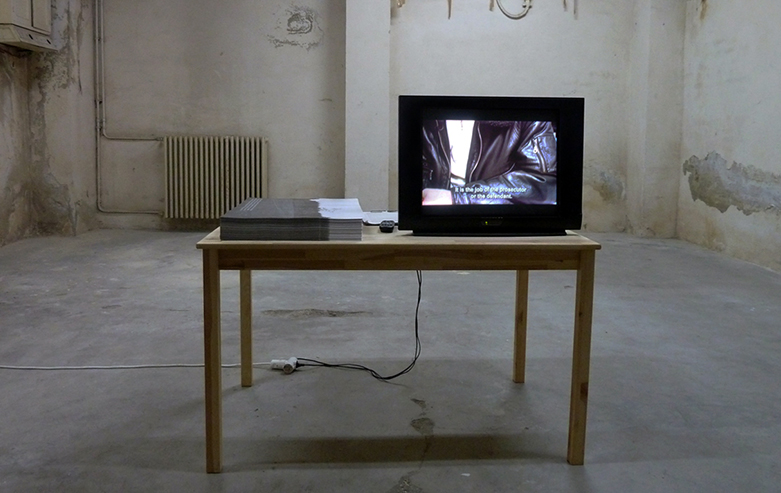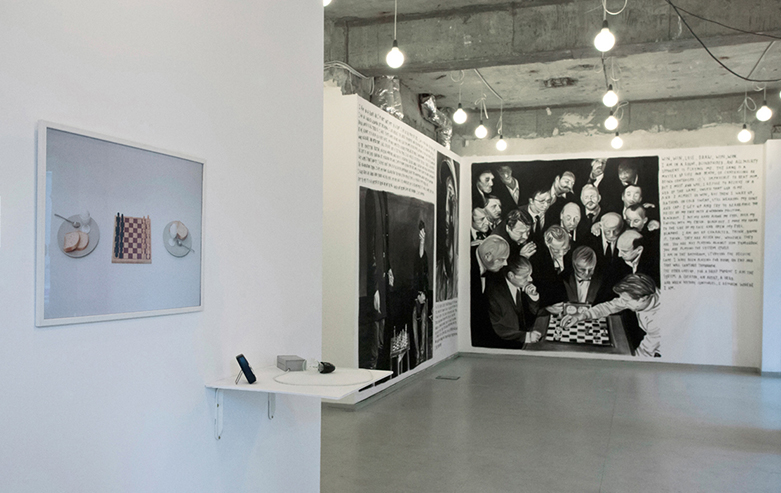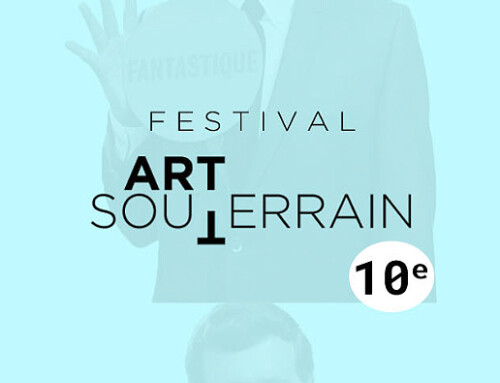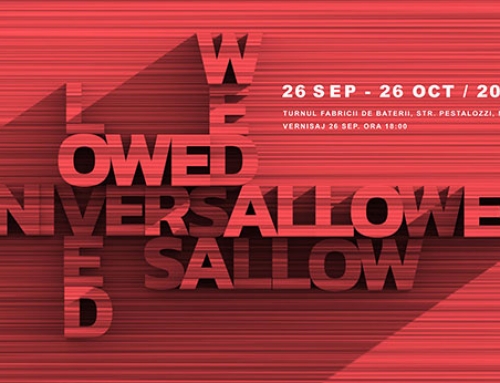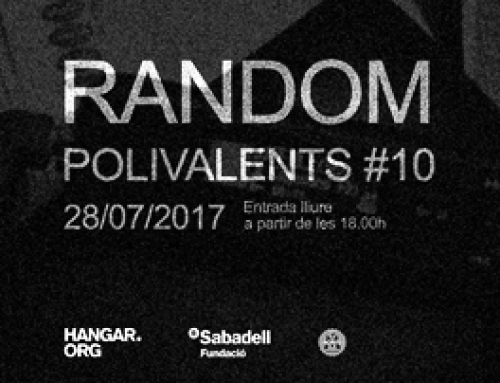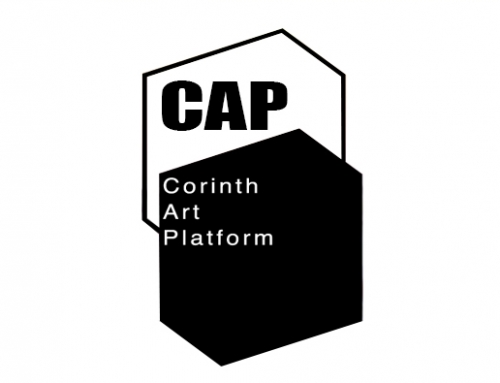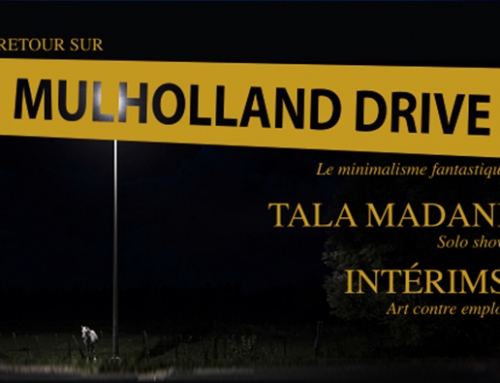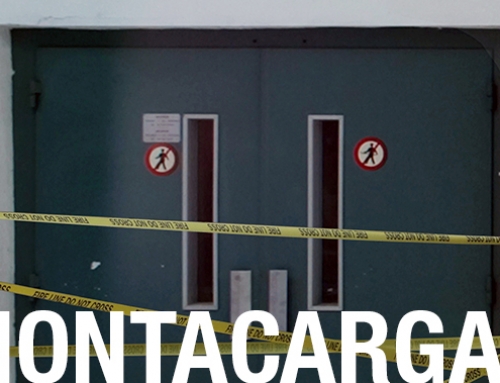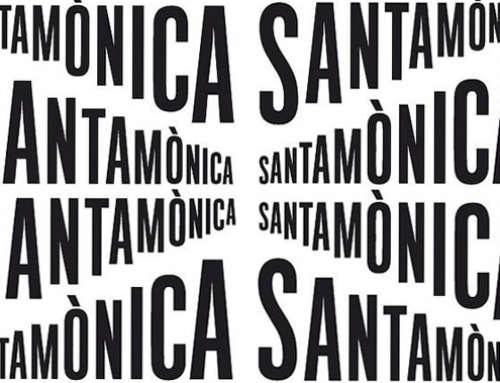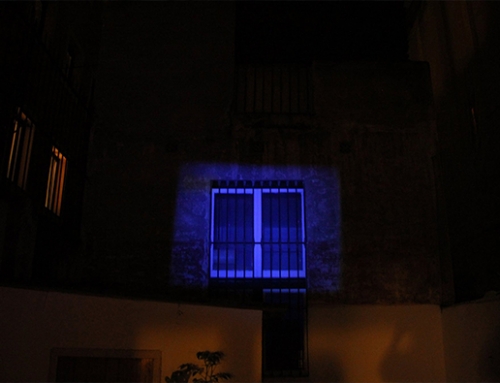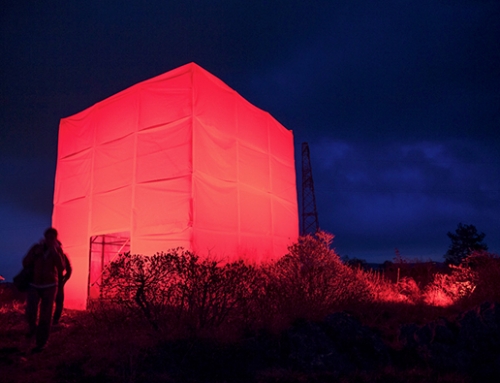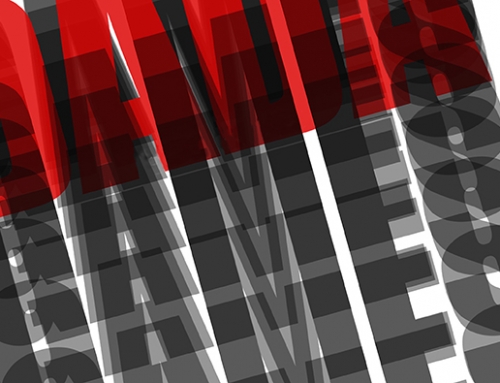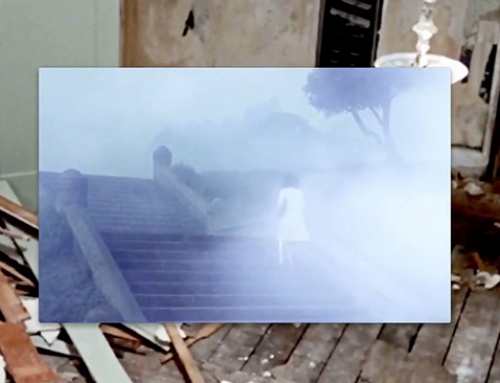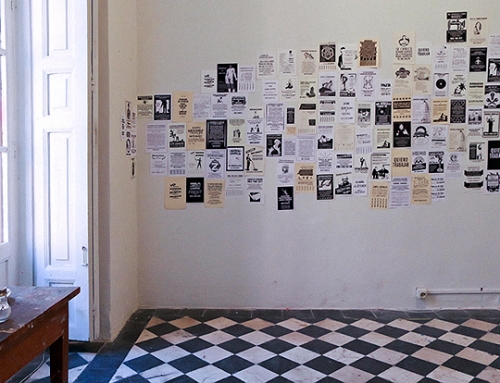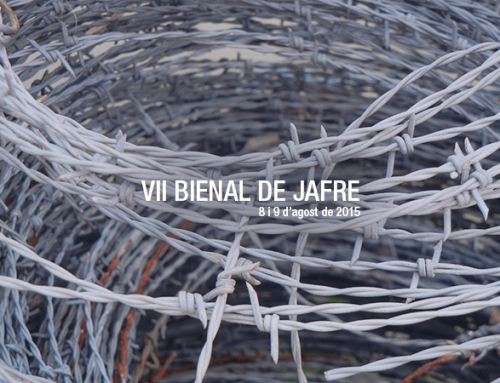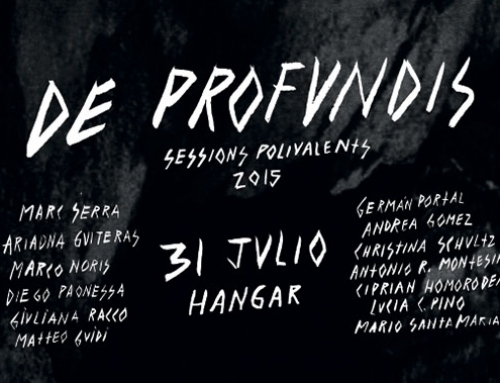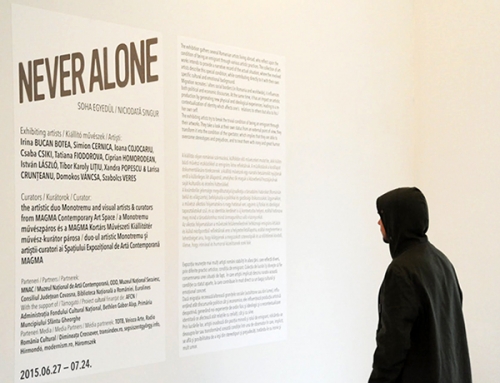25 May – 22 July, 2012.
Curator: Anne Barlow
List of Artists: Abbas Akhavan (IR/CA), Marina Albu (RO), Haris Epaminonda (CY/DE), Klas Eriksson (SE), Ruth Ewan (UK), Aurelien Froment (FR/IE), Ciprian Homorodean (RO/BE), Iman Issa (EG/USA), Janice Kerbel (CA/UK), Jill Magid (USA), David Maljkovic (HR), Marina Naprushkina (BY/DE), Ahmet Ogut (TR/NL), Vesna Pavlovic (RS), Anahita Razmi (DE), Wael Shawky (EG/FR), Alexandre Singh (FR/USA), Mounira Al Solh (LB/NL) & Bassam Ramlawi (LB), Rinus Van de Velde (BE)
Operating within the same context of the shifting nature of economics, politics and culture, are artistic practices whose agency lies in investigative or indirect approaches that possess their own kind of power. The fifth edition of the Bucharest Biennale focuses on such practices through a number of installations, environments and performances, as well as through the integration of projects within existing presentation and distribution systems outside traditionally conceived art venues. While many of the artists engage with the subjects of territories and histories, risky and unstable positions or systems of authority, they do so in a way that is characterised by ambiguity, opacity, non-linearity and the quasi-fictional, or by tactics of subterfuge and infiltration. While some use processes that are investigative or slow in the making – expressing a kind of resistance to the speed and instability of everyday life – others turn to more ‘informal’ methodologies. As Simon Sheikh points out, ‘The field of art has become-in short-a field of possibilities, of exchange and comparative analysis. It has become a field for alternatives, proposals and models, and can, crucially, act as a cross field, an intermediary between different fields, modes of perception, and thinking, as well as between very different positions and subjectivities … ‘[3]
The application of more laissez-faire approaches is dynamic and responsive and can be difficult to pin down. It is particularly resonant in Bucharest in terms of political history, infrastructure and support systems and conditions for artistic practice, which themselves are in the process of evolving. The informal has been identified by several writers as connected to societies that have experienced repression or that have undergone political transition. ‘A key feature of communism was the organisation of society into formal and informal spheres. Formally, communist society was defined by a vast number of laws, rules and regulations and the economy was regulated by short-term and long-term plans. As laws were frequently idealistic – and consequently also often unrealistic – and plans (carrying the status of law) usually too taut to be implemented, informality became a useful tool to circumvent the former and secure fulfilment of the latter. It was also used by the general public as a strategy for coping with everyday life.'[4] During that time, informal environments offered artists the opportunity, albeit within limited circles, to show and discuss their work.[5]
The informal can spring from popular culture, quotidian events and the actions of various kinds of ‘subcultures.’ Informal structures have been recognized in different sectors of society, not only in culture but also in business and management, as having the capacity to act like a shadow, operating from the ground up. Such approaches are well suited to artists whose interests lie in ways of negotiating the realms of ‘nonfiction, facts, directions, laws and … how systems work,’ observing their structure and behavior to investigate ‘where their loopholes lie.'[6] The potential of the informal in relation to agency is also acknowledged in the educational framework advanced by Pavilion’s Free Academy, where informal education is deemed more important and vital than that of the formal system, and where the type of citizen that participates in social debate becomes more of an agent of change who has the capacity to get involved.[7]
With some artists in the Biennale, tactics of subterfuge and infiltration are intrinsic to their practice, whether their work takes the form of documents of ‘tactical behavior,’ or situations that are playfully or provocatively embedded within sites of daily activity. In relation to how one defines the public domain, it is important to bear in mind William Pope.L’s comment that agency ‘is relative to context. It is not natural and freely given … . Agency is a negotiation, always mediated.'[8] As Maria Lind points out, there are differences between work that is ‘context-sensitive’ as opposed to ‘site-specific.’ Lind considers that ‘recipes must be reformulated for every occasion’ since being context-sensitive is more about being sensitive to situations and a ‘challenge to the status quo – being context-sensitive with a twist … .”[9] Within this framework, the Biennale contains several projects that generate spaces of encounter outside art venues themselves, altering the expected realities of a given context – whether this is a cinema schedule, social space, or publications on subjects other than art – allowing for moments of confusion or questioning, and ideally a curiosity as to the origins and intentions of these interventions. Such projects are not about the mere dispersal of knowledge, but, in their intentions and chosen contexts, seek to be closer to what Simon Sheikh refers to as ‘networks of indiscipline, lines of flight, and utopian questionings’ that create ‘spaces of thinking.'[10]
Information itself, in terms of how it is distributed, researched, absorbed and re-presented has of course been profoundly affected by the internet. The circulation of information and images has never been greater, leading not just an ‘expanded sociality of the web but an accelerated, highly visual, hybridized commons.’ [11] Patterns of learning about a subject have been deeply affected by the Internet’s ability to reveal formerly obscure or otherwise concealed data, as well as its potential to generate associative meaning through multiple direct and tangential searches. As John Conomos notes, we are living ‘in a world where the computer and its attendant techno-utopian myths of artifice, control and rationality create in us a sense of reality that is becoming more elaborate, more contingent, and more dependent on digital languages of representation – where the discourse between cognition and epistemology, images and knowledge is being radically alerted by electronic technologies.'[12]
User-generated sources such as Wikipedia, with its inherent potential for multiple and possibly inaccurate accounts, and the sheer act of researching links and connections from one thing to another online, provide rich material for artists interested in more associative structures, narratives and meanings. Often seductive and formal in their aesthetic presentation, their works are full of word games, tangential logic, and what may even seem flights of fancy, that render simplistic interpretation impossible – the consequences of a research and thinking process that in its very nature could be seen as a ‘permission for knowledge that is tangential and contingent and whose sociability as it were, its search for companionship, is based not on linearity and centrality but on dispersal and on consistent efforts at re-singularisation.'[13]
A strong component of the Biennale involves a reworking of certain histories from the civic to the personal, in a way that is not always about nostalgia or narrative, but is rather a deliberately constructed perspective on the contemporary. Whether referring to the architecture and symbols of past eras, or the genres of science fiction or documentary, content is altered through a process that is additive or reductive in intention and form, producing a configuration of components that require a shift in perception. Several histories or time frames may be evoked in one image, or a sense of place suggested yet concealed: in such cases, one has to ‘reorient’ the position from which one receives and processes information, setting aside assumptions and previously acquired knowledge. As Claire Staebler notes in the journal Typologies of Unlearning: Resistance, Renewal and Fresh Attempts, ‘If unlearning becomes a means of connecting with the world – an individual or collective tendency, allowing everyone to rethink, to renegotiate and to question what they believe or think they know – then art, inevitably, can help us reformulate our perceptions of the world.'[14] With several of the Biennale projects, relationships between visual art and literature also blur, not just in relation to how text is used as primary material, but in terms of how purely visual elements create ‘the imaginative space and potential that is usually associated with literature … without recourse to the trappings of language or narrative.'[15] Operating ‘in-between’ fact and fiction, history and the ‘now,’ the works draw on, as well as project, either a multiplicity – almost over-abundance – of references, or conversely, possess strength by virtue of creating a space where something seems ‘missing’ or incomplete, giving rise to ‘a multiplicity of folds and gaps in the fabric of common experience that change the cartography of the perceptible, the thinkable and the feasible.'[16]
Notes: [1] Precarity in relation to contemporary art has been explored in exhibitions including Human Condition: Empathy and Emancipation in Precarious Times, Kunsthaus Graz/Universalmuseum Joanneum, 2010, and The Workers, MASS MoCA, 2011–12; articles including Nicolas Bourriaud, ‘Precarious Constructions: Answer to Jacques Ranciere on Art and Politics,’ in A Precarious Existence: Vulnerability in the Public Domain (Rotterdam: 2009); ‘Thriving on Adversity: The Art of Precariousness,’ Anna Dezeuze, in Mute 2, 3 (September 2006); and conferences including Zones of Emergency: Artistic Interventions – Creative Responses to Conflict & Crisis, MIT Program in Art, Culture and Technology (ACT), fall 2011.[2] Hal Foster, ‘Precarious,’ Artforum (December 2009).[3] Simon Sheikh, ‘SPACES FOR THINKING: Perspectives on the Art Academy,’ Texte Zur Kunst 62.[4] Ase Berit Grodeland and Aadne Aasland, Informality and Informal Practices in East Central and South East Europe’ Complex Europe (Melbourne, 2007).[5] As noted in the essay for Agents & Provocateurs (Institute of Contemporary Art. Dunaúvaros, 2009): ‘In his fictive dialogue with Ceausescu from 1978, artist Ion Grigorescu takes the “father of the people” epithet literally, and directly addresses the political leader to offer constructive criticism. For several decades, this film of Grigorescu was only available to a narrow circle as the artist mostly worked as a restorer, secluded from the professional public.’[6] ‘Mixing Business with Pleasure,’ interview with artist Jill Magid, Base Now 15 (May, 2009).[7] Eugen Radescu, Free Academy, Pavilion, Bucharest.[8] William Pope.L, ‘Agency and What You Can Do With It,’ in Creative Time: The Book: 33 Years of Public Art in New York City, eds. Anne Pasternak and Ruth Peltason (New York, 2007).[9] Maria Lind, ‘Selected Nodes in a Network of Thoughts on Curating,’ in Selected Maria Lind Writing, ed. Brian Kuan Wood (Berlin, 2010), p. 30.[10] Simon Sheikh, ‘Talk Value: Cultural Industry and the Knowledge Economy,’ in On Knowledge Production, A Critical Reader in Contemporary Art, ed. Maria Hlavajova, Jill Winder and Binna Choi (Utrecht and Rotterdam, 2008), p. 196.[11] Lauren Cornell, ‘Walking Free,’ essay for the exhibition Free (New Museum, 2010–11).[12] John Conomos, ‘Art, the Moving Image and the Academy,’ in Rethinking the Art School: The Artist, the PhD, and the Academy, ed. Brad Buckley and John Conomos (Nova Scotia, 2009), p. 116.[13] Irit Rogoff, ‘Practicing Research: Singularizing Knowledge,’ in maHKUzine, Journal of Artistic Research 9 (2010), p. 42.[14] Claire Staebler, ‘Typologies of Unlearning: Resistance, Renewal and Fresh Attempts,’ Le Journal de la Triennale (Paris, 2012), p. 2.[15] Kaelen Wilson-Goldie, ‘Haris Epaminonda,’ Bidoun 20, p. 126.[16] Jacques Rancière, The Emancipated Spectator (London and New York, 2009), p. 72.
